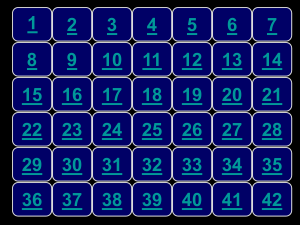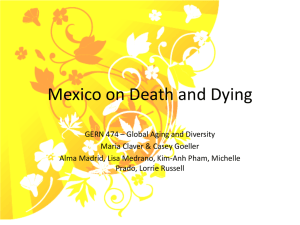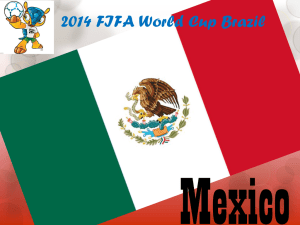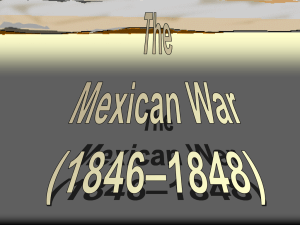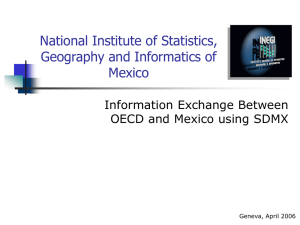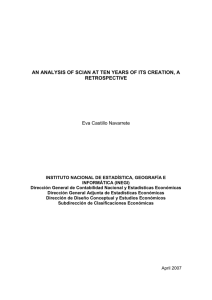Mexico
advertisement
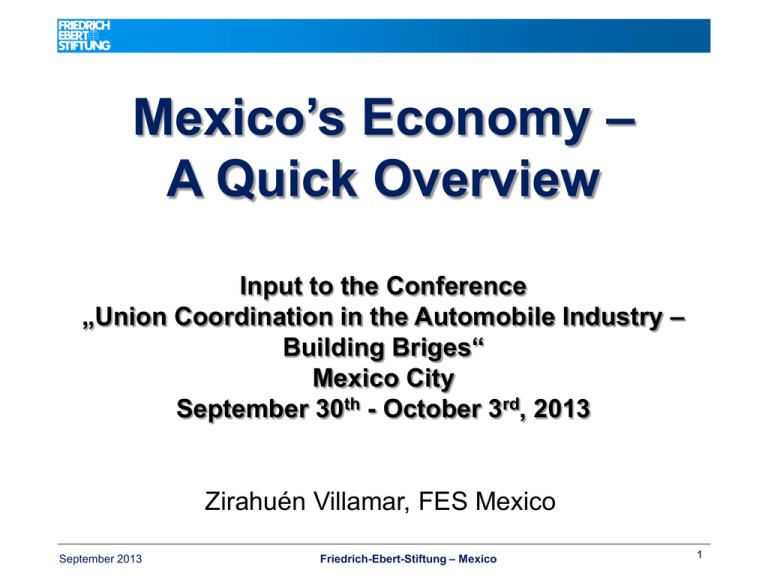
Mexico’s Economy – A Quick Overview Input to the Conference „Union Coordination in the Automobile Industry – Building Briges“ Mexico City September 30th - October 3rd, 2013 Zirahuén Villamar, FES Mexico March 2011 2013 September Friedrich-Ebert-Stiftung – AG– Mexico QUIZ Friedrich-Ebert-Stiftung 1 Mexico: A Big Economy, an Unbalanced Society Household and Personal Income (2010) GDP Size (2012) • A Middle-Class Nation? Class Houseohold % of total People Upper Middle Low • Source: World Bank http://databank.worldbank.org/data/download/GDP.pdf March 2011 2013 September … not so actually. Source: National Institute of Geography and Statistics (INEGI) http://www.inegi.org.mx/inegi/contenidos/espanol/prensa/Boletines/Boletin/Comunica dos/Especiales/2013/junio/comunica6.pdf Friedrich-Ebert-Stiftung – AG– Mexico QUIZ Friedrich-Ebert-Stiftung 2 Economic Performance – The Quest for Stability and... • • • • • • • After a traumatic and volatile 80s decade, a new culture of economic stability Big national efforts to gain external credibility in order to set foundations for economic activities within the North American integration process Reforms for the new Mexican economy NAFTA enters into force in January 1st 1994 Greater role of market forces and private actors, lesser for State policies and public players and interventions A big opening to World economy: goods, services and finances Credibility meant stability: – – – • • Inflation (Single aim, autonomous Central Bank) Public finances (Zero deficit) Exchange rate (rather free flotation) Financial crisis in 1995 (Tequila effect), with further effects on the real economy the following years A decoupling national economy: those sectors and activities (few regions and players as well) linked to the NAFTA and those (most of regions and population) not in the NAFTA orbit March 2011 2013 September Friedrich-Ebert-Stiftung – AG– Mexico QUIZ Friedrich-Ebert-Stiftung 3 Economic Performance – … the Unwanted but Logical Result: Low Growth Rationale 2008-2013 • • • • After the second trauma of 1995 crisis, the culture of stability and equilibria was reinforced Further reforms in public finances, monetary fundamentals and more free trade agreements In order to fulfill such goals, little or none chances for economic public policies were left • • • When the crisis arose, there were no countercyclical meassures available In 2009 Mexico got the worst GDP performance in Latin America The recovery has been weak Updated forecasts are getting more and more pessimistic for the upcoming years Results • • • Mediocre GDP growth, quite below potential calculations Real 30-year-average: 2% growth Exchange rate benefits exports of particular goods and lots of imports, but it doesn’t foster the internal market Source: Organization for Economic Co-operation and Development (OECD) http://www.keepeek.com/Digital-Asset-Management/oecd/economics/oecd-economicsurveys-mexico-2013_eco_surveys-mex-2013-en#page16 March 2011 2013 September Friedrich-Ebert-Stiftung – AG– Mexico QUIZ Friedrich-Ebert-Stiftung 4 Poverty – A Vulnerabilities Approach Multimensional, 2012 Data Deprivations Education Health Services Social Security Quality and Spaces of the Dwelling Basic Household Services Access to food Results 45.5% of population living in poverty (53.3 mill) Modererately poor: 37.7% of population, income under $180 usd / month (urban) or $115 usd /month (rural) (41.8 mill) Extremely poor: 9.8% of population, income under $86 usd /month (urban) or $62 usd / month (rural) (11.5mill) Source: National Council for the Evaluation of Social Development Policy (CONEVAL) http://www.inegi.org.mx/inegi/contenidos/espanol/prensa/Boletines/Boletin/Comunicados/Especiales/2013/junio/c omunica6.pdf March 2011 2013 September Friedrich-Ebert-Stiftung – AG– Mexico QUIZ Friedrich-Ebert-Stiftung 5 Labour – Not a Matter of Unemployment… Unemployment rate People at work • • • • • • Structural unemployment is below 6% Even during the worst year of the crisis (2009), this number was the peak Latest data (August 2013) shows a 4.78% Total population: 118 mill. (ca.) Economically Active Population: 52 mill. (ca.) Working population: 49 mill. (ca.) Source: National Institute of Geography and Statistics (INEGI) http://www.inegi.org.mx/inegi/contenidos/espanol/prensa/boletines/boletin/Comuni cados/Especiales/2012/Diciembre/comunica3.pdf March 2011 2013 September Source: El Economista, September 20th, 2013 http://eleconomista.com.mx/industrias/2013/09/20/desempleo-cede-su-menor-nivelseis-meses Friedrich-Ebert-Stiftung – AG– Mexico QUIZ Friedrich-Ebert-Stiftung 6 Labour – …but of Informal Employment Informal Employment • Around 60% of employment is informal: 29 mill. • Much of the employment growth has been in informal jobs • It means people (workers and their families) with no social protection • Low added-value sectors/activities • Many workers are self-employed • Geographical characteristics: Informal Employment is concentrated in Southern and Center States March 2011 2013 September Friedrich-Ebert-Stiftung – AG– Mexico QUIZ Friedrich-Ebert-Stiftung 7 Productivity Working a lot… What • People in Mexico work 2,250 hours a year, more than the OECD average of 1,776 hours. • 29% of employees work very long hours, much more than the OECD average of 9% Why • Low salaries force people to find another job to compensate their incomes • High number and hours of unpaid activities to be performed • Low productivity economic activities (informal sector) …because of low Productivity • As a whole, Mexico has the lowest Labour Productivity among OECD countries • Total Factor Productivity, has actually decreased nearly 10% compared to 1991 In some particular fields, Productivity is similar to other economies This national differences underline the disparities, whether geographical or by income • • Source: Organization for Economic Co-operation and Development (OECD) http://www.oecdbetterlifeindex.org/countries/mexico/ and http://dx.doi.org/10.1787/888932708674 March 2011 2013 September Source: Organization for Economic Co-operation and Development (OECD) http://dx.doi.org/10.1787/888932706546 Friedrich-Ebert-Stiftung – AG– Mexico QUIZ Friedrich-Ebert-Stiftung 8 Low and Stagnated Productivity • • • In the last decade, the national average Labour Productivity has decreased Ups and downs are due to the economic cycle: all in all, they are recoveries to certain levels but not true growth A significant part for low growth of GDP lies on this reason Labour Productivity Index GDP Index Working Population Index Source: National Institute of Geography and Statistics (INEGI) http://www.stps.gob.mx/bp/secciones/conoce/areas_atencion/areas_atencion/web/productividad/Aspectos.pdf March 2011 2013 September Friedrich-Ebert-Stiftung – AG– Mexico QUIZ Friedrich-Ebert-Stiftung 9 Labour costs Features • In order to attract foreign investments and to foster local competitiviness Mexican labor costs have constantly decreased compared to those of other emerging industrial countries competitors (vr.gr. China and Brazil) • This trend has its origins not only in diminishing Mexican costs by itself (flexibilization of the labour market regulation) but also in the improvements of other countries’ salaries Effects • Little or inexistent options for an internal market driven economic growth • A robust race to the bottom behavior Source: Organization for Economic Co-operation and Development (OECD) http://www.keepeek.com/Digital-Asset-Management/oecd/economics/oecd-economicsurveys-mexico-2013_eco_surveys-mex-2013-en#page16 March 2011 2013 September Friedrich-Ebert-Stiftung – AG– Mexico QUIZ Friedrich-Ebert-Stiftung 10 The Reforms The new Government (2012-2018) and the Pact for Mexico • • Great expectations Political, economical and social agreement among main Political Parties Reforms • • • • • Labour Law (2012, before new Government took office) Education (passed on August 2013) Finances and Banking (passed on September 2013) Energy (Oil and Electricity) (being disscussed now) Fiscal (being discussed now) Programmes • • • Cruzade against Hunger (Ministries and Agencies co-ordination) Democratization of Productivity (National Development Plan’s Goal) Formalizing Employment Programme (part of the Fiscal Reform) March 2011 2013 September Friedrich-Ebert-Stiftung – AG– Mexico QUIZ Friedrich-Ebert-Stiftung 11 Thank you! zirahuen.villamar@fesmex.org March 2011 2013 September Friedrich-Ebert-Stiftung – AG– Mexico QUIZ Friedrich-Ebert-Stiftung 12




